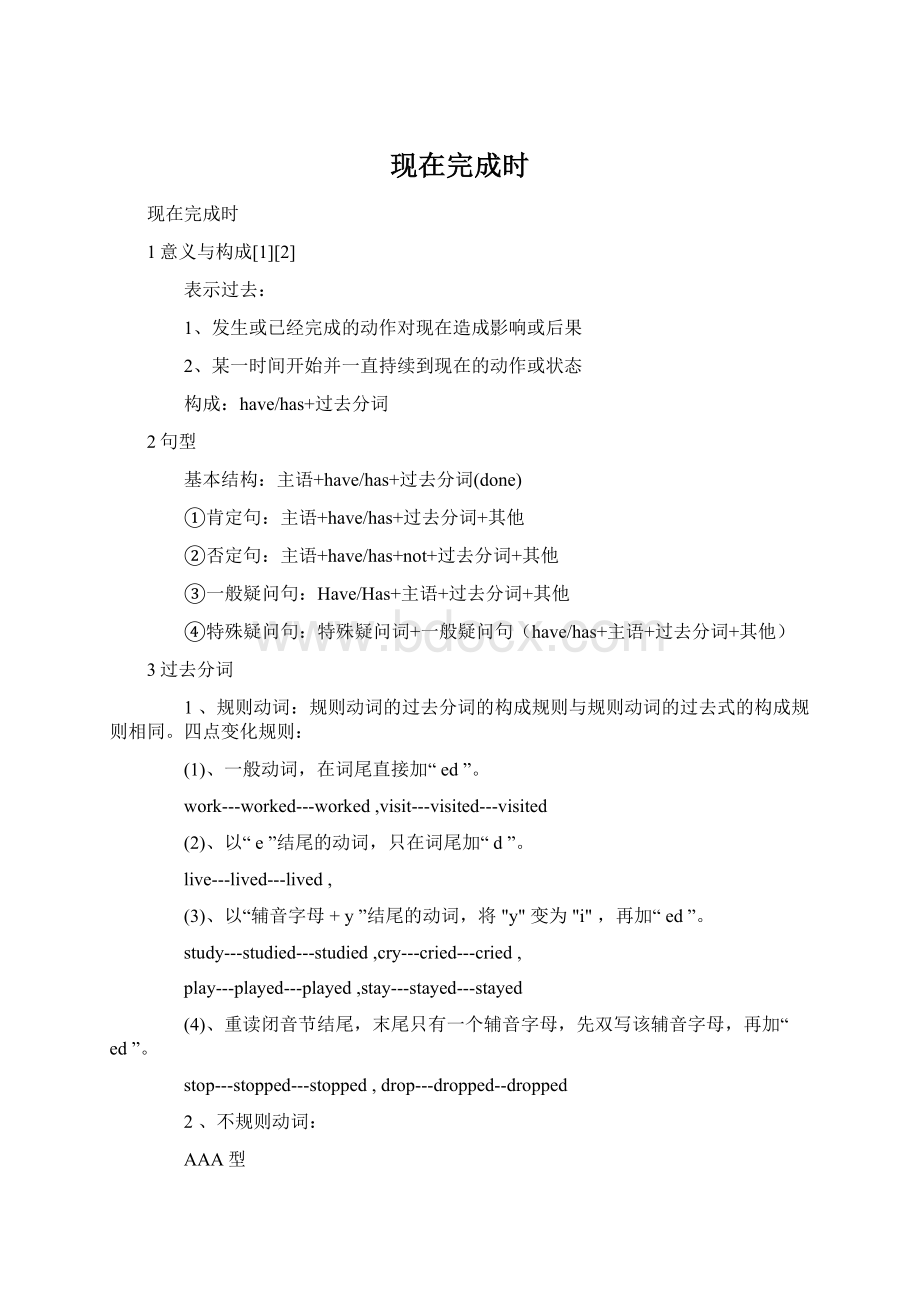现在完成时.docx
《现在完成时.docx》由会员分享,可在线阅读,更多相关《现在完成时.docx(8页珍藏版)》请在冰豆网上搜索。

现在完成时
现在完成时
1意义与构成[1][2]
表示过去:
1、发生或已经完成的动作对现在造成影响或后果
2、某一时间开始并一直持续到现在的动作或状态
构成:
have/has+过去分词
2句型
基本结构:
主语+have/has+过去分词(done)
①肯定句:
主语+have/has+过去分词+其他
②否定句:
主语+have/has+not+过去分词+其他
③一般疑问句:
Have/Has+主语+过去分词+其他
④特殊疑问句:
特殊疑问词+一般疑问句(have/has+主语+过去分词+其他)
3过去分词
1、规则动词:
规则动词的过去分词的构成规则与规则动词的过去式的构成规则相同。
四点变化规则:
(1)、一般动词,在词尾直接加“ed”。
work---worked---worked,visit---visited---visited
(2)、以“e”结尾的动词,只在词尾加“d”。
live---lived---lived,
(3)、以“辅音字母+y”结尾的动词,将"y"变为"i",再加“ed”。
study---studied---studied,cry---cried---cried,
play---played---played,stay---stayed---stayed
(4)、重读闭音节结尾,末尾只有一个辅音字母,先双写该辅音字母,再加“ed”。
stop---stopped---stopped,drop---dropped--dropped
2、不规则动词:
AAA型
原型过去式过去分词
burstburstburst
castcastcast
costcostcost
cutcutcut
hithithit
hurthurthurt
putputput
setsetset
shutshutshut
spreadspreadspread
letletlet
AAB型
beatbeatbeaten
ABA型
becomebecamebecome
runranrun
comecamecome
特殊情况
readreadread
read原形发音为/ri:
d/,过去式和过去分词发音为/red/
ABB型
bringbroughtbrought
buyboughtbought
buildbuiltbuilt
burnburntburnt
catchcaughtcaught
digdugdug
feelfeltfelt
fightfoughtfought
findfoundfound
hearheardheard
holdheldheld
keepkeptkept
laylaidlaid
leadledled
loselostlost
makemademade
meetmetmet
sellsoldsold
shootshotshot
sitsatsat
standstoodstood
sweepsweptswept
teachtaughttaught
telltoldtold
thinkthoughtthought
winwonwon
ABC型
beginbeganbegun
blowblewblown
breakbrokebroken
choosechosechosen
drawdrewdrawn
drivedrovedriven
drinkdrankdrunk
flyflewflown
forgiveforgaveforgiven
forgetforgotforgotten
freezefrozefrozen
givegavegiven
growgrewgrown
knowknewknown
rideroderidden
riseroserisen
ringrangrung
shakeshookshaken
singsangsung
sinksanksunk
swimswamswum
throwthrewthrown
writewrotewritten
4用法
(1)现在完成时用来表示现在之前已发生过或完成的动作或状态,但其结果却和现在有联系,也就是说,动作或状态发生在过去但它的影响现在还存在.
Ihavespentallofmymoney.(含义是:
现在我没有钱花了.)
Janehaslaidthetable.(含义是:
现在桌子已经摆好了.)
Michaelhasbeenill.(含义是:
现在仍然很虚弱)
Hehasreturnedfromabroad.(含义是:
现在已在此地)
(2)现在完成时可以用来表示发生在过去某一时刻的,持续到现在的情况,常与for(+时间段),since(+时间点)连用.
Maryhasbeenillforthreedays.
Ihavelivedheresince1998.
注(超重要):
瞬间动词(buy,die,join,lose……)不能直接与forsince连用。
要改变动词
come-be
goout-beout
finish-beover
open-beopen
die-bedead
………………
1.have代替buy
Mybrotherhashad(不能用hasbought)thisbikeforalmostfouryears.
2、用keep或have代替borrow
Ihavekept(不能用haveborrowed)thebookforquiteafewdays.
3、用be替代become
Howlonghasyoursisterbeenateacher?
4、用haveacold代替catchacold
Tomhashadacoldsincethedaybeforeyesterday.
5、用wear代替puton
b)用“be+形容词”代终止性动词
1、be+married代marry2、be+ill代fall(get)ill
3、be+dead代die4、be+asleep代fall(get)asleep
5、be+awake代wake/wakeup6、be+gone代lose,die,sell,leave
7、be+open代open8、beclosed代close/shut
9、be+missing(gone,lost)代lose
c)用“be+副词”代终止性动词
1“be+on”代start,begin
2“be+up”代getup
3“be+back(to)”代returnto,comebackto,gobackto
4“behere(there)”代come(arrive,reach,get)here或go(arrive,reach,get)there等等
d)用“be+介词短语”代终止性动词
1.“bein/at+地点”代替goto/cometo
2.用beinthearmy代替jointhearmy
3.“bein/at+地点”代替moveto
常用瞬间动词变延续性动词表:
1.havearrivedat/insw.gotto/reachedsw.come/gone/movedtosw.
2.havebeeninsw./at…相应的介词
3.havecome/goneout→havebeenout
4.havebecome→havebeen
5.haveclosed/opened→havebeenclose/open
6.havegotup→havebeenup;
7.havedied→havebeendead;
8.haveleftsw.→havebeenawayfromsw.
9.havefallenasleep/gottosleep→havebeenasleep;
10.havefinished/ended/completed→havebeenover;
11.havemarried→havebeenmarried;
12.havestarted/beguntodosth.→havedonesth.;
13.havebegun→havebeenon
14.haveborrowed/bought→havekept/had
15.havelost→haven’thad
16.haveputon→haveworn
17.havecaught/getacold→havehadacold;
18.havegottoknow→haveknown
19.have/hasgoneto→havebeenin
20.havejoined/havetakenpartintheleague/theParty/thearmy
→havebeenamemberof/havebeenin/havebeentheParty’smember/theleaguemember/thesoldier…
注意:
1.现在完成时不能单独与准确时间连用,(如表示过去的时间状语)
如yesterday(morning、afternoon),last(morning、afternoon)等,除非与for,since连用.
2.现在完成时往往同表示不确定的过去时间状语连用
,如already【已经】(肯定),yet【已经】(否定,疑问),just,before,recently,still,lately等:
Hehasalreadyobtainedascholarship.
Ihaven'tseenmuchofhimrecently(lately).
Wehaveseenthatfilmbefore.
Havetheyfoundthemissingchildyet?
3.现在完成时常常与表示频度的时间状语连用,
如often,sometimes,ever,never,twice,onseveraloccasion等:
HaveyoueverbeentoBeijing
IhaveneverheardBunnysayanythingagainsther.
Ihaveusedthispenonlythreetimes.Itisstillgood.
Georgehasmetthatgentlemanonseveraloccasions.
4.现在完成时还往往可以同包括现在时间在内的时间状语连用,
如now,uptothesefewdays/weeks/months/years,thismorning/week/month/year,just,today,uptopresent,sofar等:
Peterhaswrittensixpaperssofar.
Manhasnowlearnedtoreleaseenergyfromthenucleusoftheatom.
TherehasbeentoomuchraininSanFranciscothisyear.
Thefriendlyrelationsandcooperationbetweenourtwocountrieshavebeenenhancedinthepastfewyears.
Uptothepresenteverythinghasbeensuccessful.
5.现在完成时还可以用来表示过去的一个时间到现在这段时间内重复发生的动作.
Wehavehadfourtextsthissemester.
6.现在完成时的"完成用法"
现在完成时的"完成用法"指的是动作发生在过去某一时刻并已结束,但该动作对现在产生了影响,与现在情况具有因果关系。
例如:
Hehasturnedoffthelight.他已把灯关了。
(动作结束于过去,但说明的是现在的情况--灯现在不亮了。
)
现在完成时"完成用法"的特点是动作不延续,因此,该时态只能与表示不定的过去时间状语(如:
already,yet,before,recently等)、频度时间状语(如:
never,ever,once等)、包括现在时刻在内的时间状语(如:
thismorning/month/year...,today等)连用。
例如:
Haveyoufoundyourpenyet?
你已找到你的钢笔了吗?
7.现在完成时的"未完成用法"
现在完成时的"未完成用法"指的是动作开始于过去某一时刻,一直延续到现在,或可能还要继续下去。
例如:
Hehaslivedheresince1978.自从1978年以来,他一直住在这儿。
(动作起始于1978年,一直住到现在,可能还要继续住下去。
)
Ihavebeeninthearmyformorethan5years.我在部队已经呆了五年多了。
(动作开始于5年前,一直延续至今,有可能还要继续下去。
)
此种用法的句中常需一个表示一段时间的状语(由since或for引导),或表示与现在时刻相连的时间状语(如:
uptonow,sofar)等。
例如:
Ihaveheardnothingfromhimuptonow.到目前为止我没有他的任何消息。
注意:
(1)现在完成时的未完成用法只适用于延续性动词,不可用于终止性动词,即瞬间完成或延续时间很短的动词。
如:
come,go,arrive,leave,join,become,die等。
8.一段时间+haspassed+since从句
9.现在完成时常和短语"uptonow/tillnow","sofar"(意思是从过去某一确定的时间一直延续到现在.)
Upto/tillnowhe'sreadmanystorybooks.至今他已读过好多故事书。
I'vebeentoNewYorkthreetimessofar.至今我已到纽约去过三次。
10hasgone(to),hasbeen(to),hasbeen(in)的区别
gone:
去了没回
beento:
去过
beenin:
呆了很久
11.不能与when连用